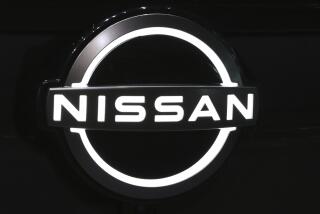New Tests Confirm It: Air Bags Really Help : Safety: The National Highway Traffic Safety Administration noted a sharp reduction in head and chest injuries when the devices are used.
- Share via
WASHINGTON — Drivers protected by air bags are significantly less vulnerable to head and chest injury in accidents, new tests indicate.
Results released Friday by the National Highway Traffic Safety Administration indicated that a front-seat passenger in the Chrysler LeBaron two-door convertible is nearly seven times as likely to sustain head injury as the driver.
In the Chrysler Imperial, a four-door sedan, the passenger is four times as vulnerable as the driver.
Both cars have air bags on the driver’s side.
The agency tested 34 vehicles ranging from subcompacts to luxury sedans and light trucks, releasing its final round of crash test results for 1990 automobiles.
Chrysler spokesman Steve Harris said it was difficult to draw conclusions from the tests because they were based on crashes under conditions that exceed government safety standards, but he said air bags have a major impact on safety and are needed for passengers as well as drivers.
“Everybody (in the auto industry) has indicated that’s the direction they’re going,” he said.
The government tested the vehicles by driving them head-on into a fixed barrier, creating the same conditions as a frontal collision between two identical vehicles driving at 35 miles per hour.
The conditions also are equivalent to a car moving at 70 m.p.h. striking an identical parked car.
Test results apply only to occupants using seat belts and, in certain cars, air bags. Tests are conducted using dummies that represent an average-size adult male.
According to the NHTSA index, a score of 750 or lower means head injury is unlikely; 750 to 1,250 means head injury is possible, and anything higher means head injury is likely.
A separate scale records the possibility of chest injury, which is considered likely when the score tops 60.
The lower the numbers, the lower the potential for injury. But for purposes of comparison, vehicles have to be of the same type and weigh within 500 pounds of each other.
The Chrysler LeBaron’s score for driver head injury was 298, well below the threshold for likely injury. But the front-seat passenger score was 2,043. Chest injury scores were 40 for the driver and 46 for the passenger.
In the Imperial, the driver head injury score was 517 while the passenger head injury score was 2,132.
Rated highest of all vehicles tested for potential driver head injury was the Ford Club Wagon van, with a score of 2,613. Its passenger score was 1,896.
The Isuzu Trooper II had the highest potential injury score for the front-seat passenger--1,952.
The Chevrolet S-10 Blazer had the highest driver chest injury score--74. The highest passenger injury score was the Trooper II’s 64.
The agency released eight crash test results Friday, including those of the Imperial and LeBaron. Others included:
- Chevrolet Cavalier four-door sedan. Head injury: 770 driver, 485 passenger. Chest injury: 49 driver, 37 passenger.
- Subaru Legacy four-door sedan. Head: 1,007 driver, 675 passenger. Chest: 52 driver, 44 passenger.
- Cadillac Deville four-door sedan. Head: 423 driver, no data available for passenger. Chest: 39 driver, 46 passenger.
- Jeep Cherokee four-door. Head: 943 driver, 841 passenger. Chest: 58 driver, 52 passenger.
- Dodge Dakota two-door pickup. Head: 1,169 driver, 558 passenger. Chest: 57 driver, 56 passenger.
- Pontiac Trans Sport van. Head: 761 driver, 595 passenger. Chest: 42 driver, 37 passenger.






